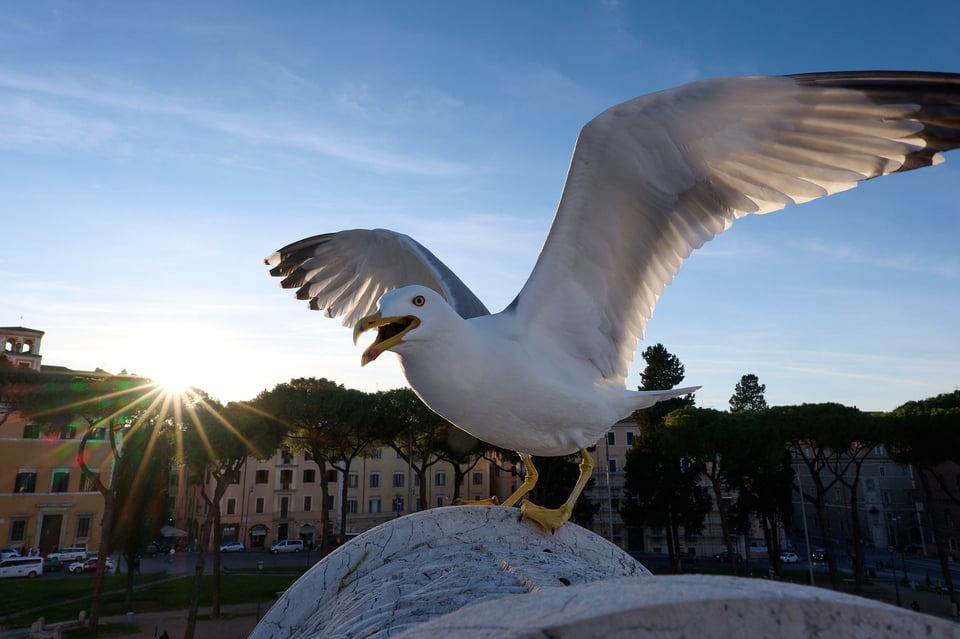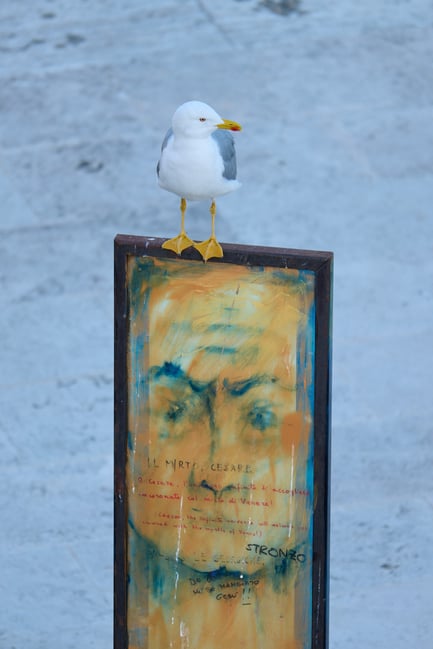“Urban wildlife.” Put together, those two words sound like a contradiction. Something like a “square circle,” “hot ice,” or “honest politician.” But cities really are full of life, and not the just two-legged kind of hairless primates. There is also a wide variety of animals to photograph. I recently returned from one of the cradles of civilization, Rome, in search of urban wildlife – camera in hand, of course.

Some animals have realized that living close to humans doesn’t always mean death. In fact, we have transformed our cities in such a way that, for certain animals, it even resembles their original rocky habitats. This is true for Rock Pigeons, Black Redstarts, and even Peregrine Falcons. Cities also have tree-covered parks, bodies of water, and gardens – a wide variety of habitats. But most of all, the food! The piles of food we humans throw away become a veritable buffet for animals who can stomach it.

The photos in this article have several things in common. I took all of them within a few days in a city previously unknown to me. and they were all taken somewhere in the triangle bounded by St. Peter’s Basilica in Vatican City, the Colosseum, and St. Maria in Trastevere. To take them, I walked a total of 62 km (about 39 miles) and replenished my energy many times with croissants, coffee, and pizza.

My two fellow photographers and I originally went to Rome to photograph the giant murmurations of starlings. You may have seen something like this with your own eyes, or at least in a documentary. These massive flocks give the impression of a single mega-organism in the sky.
Our visual intention was to capture huge groups of thousands of birds forming strange formations in the sky above millennia-old structures. However, it was shattered by the fact that the largest flock of starlings we saw over the city consisted of a mere 22 individuals. We had no choice but to improvise.
How to Look for Wildlife in Cities
Many urban animals have shed their innate shyness of humans and can be approached at arm’s length. Among the boldest are pigeons, ducks, and seagulls. Similarly tame are certain rodents, especially squirrels in city parks and nutria along rivers. Their other cousin, the rat, is not so well-loved and usually remains wary of human contact.
In general, the best place to find animals in a city is where they have an abundant supply of food or a quiet place to live. This means that they are most likely to be found in open-air markets where food is sold, around restaurants, or simply wherever a generous human hand can be found. In any of these places, you can see animals whose shyness is long gone.

I know that wildlife photographers are loathe to feed their subjects, and rightly so. Without knowing the diets of these creatures, you can do more harm than good. But a few pieces of bread or some bird seed are likely healthier than the usual diets of urban wildlife. Just be careful not to do the animals a disservice if you offer them food. Small birds in particular are very sensitive to the amount of salt they receive.

How to Photograph Animals in Cities
There are basically two ways to approach the subject of urban wildlife photography. We can either show the existence of the city in our photographs, or we can try to deny or at least suppress it.

To me, incorporating the manmade background into your urban wildlife photos can be very powerful. Whereas photos in nature usually have a limited color palette of brown and green, and usually have trees as the background, cities offer you much more choice. You can experiment with wildly different colors, lines, regularity, rhythm, and patterns of light and shadow.

The city truly offers endless possibilities. The element of surprise, or the power of contrast, works very well. It’s also a way to tell powerful stories, both bad and good. Bald eagles on a pile of garbage, a cougar in front of the Hollywood sign, a bear on a child’s swing, and more. (These examples are all real photos, by the way).

You can also incorporate elements of reportage and humor into urban wildlife photography. The interactions with people or manmade objects are a great way to tell a story.


There is another advantage to photographing wildlife in the city: There is less of a need to use long telephoto lenses, as in traditional wildlife photography. While I took several of the photos on my trip to Rome with a 180-600mm telephoto, I also took several with a 24-120mm f/4 zoom (and not always at 120mm). Since you can walk closer to frame your subject, or allow it to be small relative to the grand urban landscape, a midrange zoom becomes a powerful wildlife photography tool.

Another option you have is to “suppress the city” and take wildlife photos that give the illusion of being captured in nature. You might be surprised at how easy this is in an urban environment, but the presence of parks and bodies of water makes it pretty seamless.
All you have to do is take a telephoto lens and, with a carefully chosen angle of view, hide what you don’t want to show. A shallow depth of field will do the rest. At the corner of a high-rise building with some trees out front, you can extract a photographic gem that looks like it was taken in the bosom of pristine nature.

Sometimes a combination of the two approaches works well. That is, you want the photo to look like it was taken in nature, but at the same time you want to give it a touch of the city. For example, it could be just a reflection of a colored wall in the water’s surface. Or, it could be distant street lamps, which look nice when the telephoto lens renders them as out-of-focus circles. Just look around and experiment.

Other Considerations for Urban Wildlife Photography
Most of our usual tips for wildlife photography apply in urban environment, but there are some differences.
It starts with light. For the photographer, the sun is the primary source of light, even in urban environments. But the ability to pair natural light with artificial light is relatively unique to the city. Likewise, buildings and other structures may hide the sun just like a giant forest. Never forget that without good light, there is not a good photo.

Another consideration is the hour that you’re taking pictures. Have you chosen a city park, botanical garden, or historical landmark for your sunrise or sunset shot? If so, check the opening hours so you don’t waste the best part of the day standing outside the gates.

Also, check restrictions on photographic equipment. In some places, you can’t take pictures with a camera that’s bigger than a small one and a lens that’s longer than a short one. At least, that’s how the security guards at the Altare della Patria explained it to me!
For some strange reason, some places don’t like the quality of your photos to exceed the standard of a smartphone, and unfortunately you have to respect that. Other places don’t want you to set up a tripod, which makes sense if it could become a tripping hazard for anyone nearby.

“Homo homini lupus est!” That’s how an educated Roman at the turn of the era might have warned you about robbers. In other words, you can walk around St. Peter’s Square in the Vatican with an expensive camera, but there are many other places where this would be a bad idea.
Even in cities or areas where concepts like “security” and “the right to private property” are empty concepts, you can take urban wildlife photos if you plan ahead of time. Botanical gardens, which are often fenced, paid for, and guarded, tend to be suitable. These three aspects could guarantee a peaceful photo session.

Although it doesn’t always seem like it, even urban animals are wild. So never touch them! Especially not mammals that can carry rabies. The loss of shyness towards humans can sometimes lead to aggression if the animal doesn’t get what it wants from you.
Within sight of Victoria Falls, I witnessed a male baboon grab an unfortunate woman carrying food in a basket on her head, shake her, and “harvest” the food she had inside, like a fruit picker harvesting ripe apples. I’m sure it made for quite a story, but even so, you probably don’t want this to happen to you.

Conclusion
The urban wilderness offers endless possibilities for photographers and can be a great source of inspiration for the discerning eye. Moreover, urbanization is a rather dynamic process. Some animals have been with us for millennia, while others are just developing a taste for coexistence with humans. Maybe you can capture some of this interesting history with your camera.

The great thing is that the city with its animal inhabitants often starts right in front of your door. If you aren’t able to take time off work or afford a pricey vacation, just stay where you are and look for urban wildlife.
Also, urban wildlife photography is a genre that can be done without expensive equipment. In fact, interesting photos can be taken with the camera you always have with you, your smartphone. Just give it a try.

I wish you a lot of fun and luck in discovering and photographing urban wildlife. Let me know in the comments if you have any questions.
Great shots Libor!
I really like urban wildlife photography, although I mostly try to make the pictures look “natural”. Best thing about it is that most animals are well habituated to humans so you barely cause any disturbance.
One of my personal favourite places for urban wildlife photography is Tel Aviv – there are lots of nice parks around the city, and especially during migration season, you get a wide variety of bird species.
I live in an urban area, Milwaukee, Wisconsin USA, with local rivers, an extensive park system and Lake Michigan as our eastern boundary. There are virtually unlimited photo opportunities across the area. We have deer, racoons, foxes, opossum, nesting raptors, a heron rookery, waterfowl, and late last year a group of wayward flamingos.
When I need a day out, I pick one of the parks and head there early. I can start thee day with the sunrising over the lake and then photograph birds and other wildlife througout the day!
One great opportunity with urban wildlife is that they can be a lot more predictable in their activities than animals out in the true wild. They’ll often live within relatively small bounds in a park, and do similar things every day.
There was a heron in my local park that would fly right down to the pond’s edge, a few metres (if even that) from the people that had just arrived. It had learned that some people would throw bread to the fish, resulting in a buffet for an industrious fish-eater!
This made for a reliable and frequently repeatable opportunity to capture feeding behaviour at much closer ranges than would usually be possible. A great chance to experiment with angles, framing, etc.